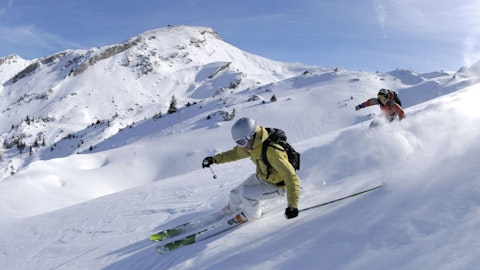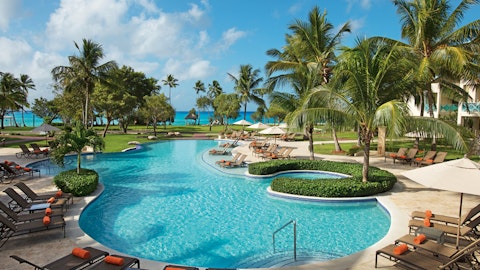Vail Resorts, Inc. (NYSE:MTN) Q4 2023 Earnings Call Transcript September 28, 2023
Vail Resorts, Inc. misses on earnings expectations. Reported EPS is $-3.35 EPS, expectations were $-3.24.
Operator: Good afternoon, and welcome to the Vail Resorts Fiscal 2023 Fourth Quarter Earnings Call. Today’s conference is being recorded. Currently, all callers have been placed in a listen-only mode and following management’s prepared remarks, the call will be opened up for your questions. [Operator Instructions] I will now turn the call over to Kirsten Lynch, Chief Executive Officer of Vail Resorts. You may begin.
Kirsten Lynch: Thank you. Good afternoon, everyone. Welcome to our fiscal 2023 year-end earnings conference call. Joining me on the call this afternoon is Angela Korch, our Chief Financial Officer. Before we begin, let me remind you that some information provided during this call may include forward-looking statements that are based on certain assumptions and are subject to a number of risks and uncertainties as described in our SEC filings and actual future results may vary materially. Forward-looking statements in our press release issued this afternoon along with our remarks on this call are made as of today, September 28, 2023, and we undertake no duty to update them as actual events unfold. Today’s remarks also include certain non-GAAP financial measures.

IZZ HAZEL/Shutterstock.com
Reconciliations of these measures are provided in the tables included in our press release, which along with our Annual Report on Form 10-K were filed this afternoon with the SEC and are also available on the Investor Relations section of our website at www.vailresorts.com. Let’s turn to our fiscal 2023 and fourth-quarter results. Given the significant weather-related challenges this past season, we are pleased with our overall results for this year, with strong growth in 2022-2023 North American ski season visitation and spending compared to the prior year, further supported by the stability created by our advanced commitment products. The return to normal staffing levels enabled our mountain resorts to deliver a strong guest experience, resulting in a significant improvement in guest satisfaction scores, which exceeded our pre-COVID levels at our destination mountain resorts.
Visitation growth was achieved through strong growth in pass sales, the addition of Andermatt-Sedrun in Switzerland, the full-year impact of Seven Springs Mountain Resorts, Hidden Valley Resort, and Laurel Mountain Ski Area acquired on December 31, 2021, and record visitation and resort net revenue in March and April. Ancillary businesses, including ski school dining and retail rental experienced strong growth compared to the prior period, when those businesses were impacted by capacity constraints driven by staffing, and in the case of dining by operational restrictions associated with COVID-19. Our dining business rebounded strongly from the prior year though underperformed expectations for the year, as guest dining behavior did not fully return to pre-COVID levels following two years of significant operational restrictions associated with COVID-19.
Our overall results through the 2022-2023 North American ski season highlight the stability of the advance commitment from season pass products in a season with challenging conditions, including travel disruptions during the peak holiday period, abnormal weather conditions, which significantly reduced operating days, terrain availability, and activity offerings across our 26 Midwest, Mid-Atlantic, and Northeast resorts and severe weather disruptions at our Tahoe resorts. This past season, approximately 75% of skier visitation at our North American resorts, excluding complementary visits, was from pass holders, who committed in advance of the season, which compares to approximately 72% for the 2021-2022 North American ski season. Results in our fourth quarter declined from the prior year, primarily driven by the company’s fiscal 2023 investments in employees as well as below-average snowfall and snowmaking temperatures that limited terrain availability during the Australian winter season.
North American summer operations also underperformed expectations, driven by a combination of lower demand for destination mountain travel, which we believe was primarily driven by a broader shift in summer travel behavior associated with a wider variety of vacation offerings available following various travel restrictions in the prior two years and weather-related operational disruptions. Turning now to our 2023/2024 season pass sales. Advance commitment continues to be the foundation of our strategy, shifting guests from short-term refundable lift ticket purchases to a non-refundable commitment before the season starts in exchange for greater value. We are pleased with the results of our season pass sales to date, which demonstrate the compelling value proposition of our pass products, our network of mountain resorts and our commitment to continually investing in and delivering a strong guest experience.
Through September 22, 2023, North American ski season pass sales increased approximately 7% in units and 11% in sales dollars, as compared to the period in the prior year through September 23, 2022. Pass product sales are adjusted to eliminate the impact of foreign currency by applying an exchange rate of $0.74 between the Canadian dollar and the US dollar in both periods for Whistler Blackcomb pass sales. Relative to the 2022-2023 season, the company achieved strong loyalty among its pass holders with particularly strong pass sales growth from renewing pass holders, while also growing pass sales among new pass holders. The company successfully grew units across destination, international, and local geographies with the strongest unit growth in destination markets, including the Northeast and across all major pass product segments with the strongest growth — product growth in regional pass products and the Epic Day Pass product as lower frequency guests and local Northeast guests continue to be attracted by the strong value proposition of these products.
The business also achieved positive growth in the Midwest and Mid-Atlantic, which after challenging conditions last season, highlights the stability of our advance commitment program, the loyalty of our guests, and significant opportunity to drive pass penetration in the Midwest, Mid-Atlantic, and the Northeast. Pass sales dollars continue to benefit from the 8% price increase relative to the 2022-2023 season, particularly offset — partially offset by the mixed impact from the growth of Epic Day Pass products. As we enter the final period for season pass sales, we expect our December 2023 growth rate may moderate relative to our September 2023 growth rate, given the impact of moving purchasers earlier in the selling cycle. We continue to prioritize advance commitment as the best way for guests to access our mountain resorts.
Similar to prior season, lift ticket sales will be limited during the 2023-2024 season in order to prioritize guests committing in advance with season passes and to preserve the guest experience at each resort. We expect these lift ticket limitations will further support our resorts and communities on peak days, and we do not anticipate that the limitations will have a significant impact on our financial results, consistent with prior seasons. As a reminder, no reservations are required at any of the resorts on the Epic Pass for pass holders, other than at our partner resort Telluride. Now, I would like to turn the call over to Angela to further discuss our financial results and fiscal 2024 outlook.
Angela Korch: Thank you. As Kirsten mentioned, given the significant weather-related challenges this past season, we are pleased with our results for the fiscal year 2023. Net income attributable to Vail Resorts was $268.1 million or $6.74 per diluted share for fiscal year 2023, compared to net income attributable to Vail Resorts of $347.9 million or $8.55 per diluted share for fiscal 2022. The decrease in net income attributable to Vail Resorts compared to the prior year was primarily due to the large gain on disposal of fixed assets in fiscal 2022, and an increase in fiscal 2023 expense associated with a change in the estimated fair value of the contingent consideration liability related to our Park City resort lease. Resort reported EBITDA was $834.8 million in fiscal year 2023, compared to resort reported EBITDA of $836.9 million in the prior year.
Now, turning to our outlook for fiscal 2024. As we head into our fiscal year, we are encouraged by the strength in advance commitment product sales and remain committed to delivering a strong guest experience, while maintaining cost discipline. We expect meaningful growth for fiscal 2024 relative to fiscal 2023, with strong resort EBITDA margin. Our guidance for net income attributable to Vail Resorts is estimated to be between $316 million and $394 million for fiscal 2024. We estimate resort reported EBITDA for fiscal 2024 will be between $912 million and $968 million. We estimate resort EBITDA Margin for fiscal 2024 to be approximately 31%, using the midpoint of the guidance range. Fiscal 2024 guidance includes an expectation that the first quarter of fiscal 2024 will generate net loss attributable to Vail Resorts between $191 million and $168 million, and resort reported EBITDA between negative $154 million and negative $104 million.
At the midpoint of the guidance range, first quarter fiscal 2024 resort reported EBITDA assumes a negative impact of approximately $46 million compared to the first quarter of fiscal 2023, excluding exchange rate impacts, primarily driven by cost inflation, which includes $7 million impact of our fiscal 2023 employee investment, which went into effect in October of 2022, lower results from our Australian resorts, from the continuation of the weather-related challenges that impacted terrain in the fourth quarter of fiscal 2023, and lower results from North American summer operations from the continuation of the lower demand for destination mountain travel experienced in the prior fiscal quarter. Relative to fiscal 2023, fiscal 2024 full-year guidance also reflects a negative resort reported EBITDA impact of approximately $3 million, as a result of the company’s exit of its retail and rental locations in Telluride and Aspen in fiscal 2023.
The guidance assumes a continuation of the current economic environment and normal weather conditions for 2023-2024 North American and European ski season, and the 2024 Australian ski season. The guidance assumes an exchange rate of $0.74 between the Canadian dollar and US dollar, related to the operations of Whistler Blackcomb in Canada, an exchange rate of $0.64 between the Australian dollar and US dollar, related to the operations of Perisher, Falls Creek and Hotham in Australia, and an exchange rate of $1.10 between the Swiss franc and US dollar, related to the operations of Andermatt-Sedrun in Switzerland. The current fiscal 2024 exchange rate assumptions result in an expected $5 million negative impact, relative to fiscal 2023 results, and an expected $10 million negative impact relative to our original fiscal 2023 guidance provided in September of 2022.
While we are cognizant of the broader macroeconomic outlook, remains uncertain, which we will continue to monitor heading into the upcoming season, we believe that we will continue to benefit from the stability and resilience of the business model, particularly with the strength, scale, and affordability of our advanced commitment products and the diversification of our resort network. Our balance sheet remains strong and the business continues to generate robust cash flow. Our total cash and revolver availability as of July 31, 2023, was approximately $1.2 billion, with $563 million of cash on hand and $646 million of combined revolver availability across our credit agreements. As of July 31, 2023, our net debt was 2.7 times trailing 12 months total Reported EBITDA.
The company declared a quarterly cash dividend of $2.06 per share of Vail Resorts’ common stock that will be payable on October 26, 2023, to shareholders of record as of October 10, 2023. During the quarter, the company repurchased approximately 400,000 shares of common stock at an average price of $247, for a total of approximately $100 million. Including the shares repurchased during the fourth quarter, the company repurchased a total of approximately 2.2 million shares of common stock during the fiscal 2023 at an average price of approximately $229 for a total of $500 million, leveraging the capital we raised opportunistically over the past few years at a low cost of debt to capitalize on an opportunity to repurchase shares at an attractive valuation.
We remain committed to returning capital to shareholders and intend to maintain an opportunistic approach to future share repurchases. We will continue to be disciplined stewards of our capital and remain committed to prioritizing investments in our guest and employee experience, high-return capital projects, strategic acquisition opportunities, and returning capital to our shareholders through our quarterly dividend and share repurchase program. Now, I will turn the call back to Kirsten.
Kirsten Lynch: Thank you, Angela. We remain dedicated to delivering an exceptional guest experience and will continue to prioritize reinvesting in the experience at our resorts, including consistently increasing capacity through lift, terrain, and food and beverage expansion projects. As previously announced, the company expects to invest approximately $180 million to $185 million in the calendar year 2023, excluding one-time investments related to integration activities, deferred capital associated with previously delayed projects, reimbursable investments associated with insurance recoveries, and growth capital investments at Andermatt-Sedrun. At Keystone, we plan to complete the transformational lift-served terrain expansion project in Bergman Bowl, increasing lift-served terrain by 550 acres with the addition of a new six-person high-speed lift.
At Breckenridge, we plan to upgrade the Peak 8 base area to enhance the beginner and children’s experience and increase uphill capacity from this popular base area. The investment plan includes a new four-person high-speed, five-chair to replace the existing two-person, fixed-grip lift, as well as significant improvements, including new teaching terrain and a transport carpet from the base, to make the beginner experience more accessible. At Whistler Blackcomb, we plan to replace the four-person, high-speed Fitzsimmons lift with a new eight-person, high-speed lift. At Stevens Pass, we are planning to replace the two-person, fixed-grip Kehr’s Chair lift with a new four-person lift, which is designed to improve out-of-base capacity and guest experience.
At Attitash, we plan to replace the three-person fixed-grip Summit Triple lift with a new four-person high-speed lift to increase uphill capacity and reduce guests’ time on the longest lift at the resort. We currently plan to complete these lift projects in time for the 2023-2024 North American winter season. The Company is planning to pilot My Epic Gear at Vail, Beaver Creek, Breckenridge, and Keystone for a limited number of pass holders during the 2023-2024 North American ski season, which will introduce a new membership program that provides the best benefits of gear ownership with more choice, lower cost, and no hassle. My Epic Gear provides its members with the ability to choose the gear they want for the full season or for the day, from a selection of the most popular and latest ski and snowboard models, and have it delivered to them when and where they want it, guaranteed with free slopeside pick up and drop off every day.
In addition to offering the best skis and snowboards, My Epic Gear will also offer name-brand, high-quality ski and snowboard boots with customized insoles and boot fit scanning technology. The entire My Epic Gear membership, from gear selection, to boot fit, to personalized recommendations, to delivery, will be at the members’ fingertips through the new My Epic app. My Epic Gear will officially launch for the 2024/2025 winter season at Vail, Beaver Creek, Breckenridge, Keystone, Whistler Blackcomb, Park City Mountain, Crested Butte, Heavenly, Northstar, Stowe, Okemo, and Mount Snow, and further expansions are expected in future years. The Company is also planning to introduce new technology for the 2023/2024 ski season at its US resorts that will allow guests to store their pass product or lift ticket directly on their phone and [Technical Difficulty] need for carrying plastic cards, visiting the ticket window, or waiting to receive a pass or lift ticket in the mail.
Once loaded on their phones, guests can store their phone in their pocket and get scanned hands-free in the lift line using Bluetooth low energy technology, which is designed for low energy usage to minimize the impact on a phone’s battery life. In addition to the significant enhancement of the guest experience, this technology will also, ultimately, reduce waste of printing plastic card for pass products and lift tickets and RFID chips, as a part of the company’s Commitment to Zero. For the first year of launch, to ensure a smooth transition, the Company will provide plastic cards for passes and lift tickets to all guests, and in future years, plastic cards will be available to any guests who cannot or do not want to use their phone to store their pass product or lift ticket.
We are also excited to announce the launch of our new My Epic app, which will include Mobile Pass and Mobile Lift Tickets, interactive trail maps, real-time and predictive lift line wait times, personalized stats, My Epic Gear, and other relevant information to support the guest experience. The Company is also investing in network-wide scalable technology that will enhance our analytics, e-commerce and guest engagement tools to improve our ability to target our guest outreach, personalize messages and improve conversion. Including $10 million of deferred capital associated with previously delayed projects, $4 million of reimbursable investments associated with insurance recoveries $1 million of onetime investments related to integration activities and $9 million of growth capital investments at under month-to June, our total capital plan for calendar year 2023 is expected to be approximately $204 million to $209 million.
In addition to this year’s significant investments across lift, expanded terrain and enhanced guest facing technology, we are pleased to announce some select projects for calendar year 2024 capital plan with the full capital investment announcement planned for December 2023. At Whistler Blackcomb, we plan to replace the four-person high speed Jersey Cream lift with a new six-person high-speed lift. This lift is expected to provide a meaningful increase to uphill capacity and better distribute guests at a central part of the resort. At Hunter Mountain, we plan to replace the four-person fixed-grip Broadway lift with a new six-person high-speed lift and plan to relocate the existing Broadway lift to replace the two-person fixed-grip E lift, providing a meaningful increase in uphill capacity and improved access to terrain that is key to the progressive learning experience for our guests.
At Park City Mountain, we expect to engage in the planning process to support the replacement of the Sunrise lift with a new 10-person gondola in partnership with the Canyons Village Management Association In calendar year 2025, which will provide improved access and enhanced guest experience for existing and future developments within Canyons village. These projects are subject to approval. In closing, we greatly appreciate the loyalty of our guests this past season and the continued loyalty of our pass holders that have already committed to next season. With our Australia winter season coming to a close, I would like to thank our frontline employees for their passion and dedication to delivering an experience of a lifetime to our guests. And we all look-forward to a great upcoming winter season in the US, Canada, and Europe.
At this time, Angela and I will be happy to answer your questions. Operator, we are now ready for questions.
See also 12 Most Popular Food Delivery Services in the US and US Alcohol Exports by Country: Top 15.
Q&A Session
Follow Vail Resorts Inc (NYSE:MTN)
Follow Vail Resorts Inc (NYSE:MTN)
Operator: [Operator Instructions] We’ll take our first question from Shaun Kelley with Bank of America. Your line is open.
Shaun Kelley: Hi, good afternoon, Kirsten and Angela. Thanks for taking my question. Maybe just to lead off, we’ve gotten a lot of requests to get a little bit more color on sort of the breakdown of what’s happening in the fiscal first quarter here. So the question here is just, could you give us a little bit more color on the $46 million? Specifically how much of that contribution is sort of from Australia and how much is a little bit more recurring on the — possibly recurring on the US resort disruption there as it relates to just changing visitation patterns? Thank you.
Kirsten Lynch: Yeah, thank you, Shaun. Thanks for the question. Related to fiscal year ‘24 and Q1, we do have some unique items that are impacting us. In Q1, we have inflation and the impact of — including the impact of our employee investment, the Australia winter conditions impact, and then to a lesser extent, our North American summer impact as well. When we look at that in total, that is a big impact for us on the fiscal year. When you take out that Q1 impact and look at the rest of the year for winter, I think we feel quite good about the fiscal year plan and the margin that we expect to deliver as a result.
Shaun Kelley: Okay, and then my follow-up would just be maybe a little bit more color on that remainder of the year. And Kirsten, we’ve talked about this before. Obviously, you’ve experienced some weather volatility over the last number of years, and I think you typically guide to normal season conditions. Is there — would you consider this a similar policy to how you’ve approached this before? Is there any more conservatism baked in here just given the weather volatility we’ve experienced and especially coming off this past season where things were particularly rocky?
Kirsten Lynch: Yeah, you’re absolutely right, Shaun, and we had a lot of disruptions this past season. We are planning for normal again. Obviously, weather disruptions are very hard to predict. I think the way we approach our guidance range is it assumes normal condition across our resorts which leads upside for strong weather conditions and downside for challenging weather conditions. And there’s normal conditions and normal disruptions like wind-hold, but an example of something abnormal would be like what happened to us in the East. It is really — so yes, we are guiding our guidance range to normal conditions and our business model as you know is very focused on trying to mitigate those impacts with our geographic diversity, advanced commitment, getting as many guests as we can committed in advance of the season, investing in snowmaking, and our Commitment to Zero and our sustainability actions as well.
Shaun Kelley: Thank you very much.
Operator: Thank you. Our next question will come from Laurent Vasilescu with BNP Paribas. Your line is open.
Laurent Vasilescu: Good afternoon. Thank you very much for taking my question. I wanted to ask about ancillary services. They’ve been impacted over the last few years. I just love — I know you guys don’t guide to it, but how are you thinking about that business recovery? Is there a benefit maybe from inflation, from food inflation, beverage inflation, any kind of inflation on that as we think about this year?
Kirsten Lynch: Yeah, we are expecting, Laurent, strong growth across our ancillary businesses with particular focus on F&B, as I highlighted in the remarks. F&B grew significantly last year but did not return all the way to pre-COVID. We know that we delivered a strong guest experience and that we are recovering from significant restrictions that were put on our dining business in the years following COVID, including a requirement for reservations, a requirement for vaccines, reduced menu options. So as we think about that business, we expect to continue on a strong growth trajectory for that dining business and we’re very focused on building awareness of all of the unique food variety offerings we have, building awareness among our more than 2 million pass holders that we had last year, about the 20% discount that’s a part of the loyalty benefits that they have as pass holders, which certainly helps mitigate some of those inflationary prices.
And we have the new My Epic app that we’ll be launching where we can start to talk to our guests one-to-one about our ancillary businesses through the app, which we also hope will give us the opportunity to have some personalized communication to help build awareness and bring people back into our restaurants and continue that growth trajectory that we’ve been on.
Laurent Vasilescu: Okay, very, very helpful. And then — sorry, I’m going to follow-up on to Shaun’s question because it is a question that we’re asking about that $46 million. In the comments, it says primarily driven by cost inflation, sounds like primarily means over half. Is that the right way to think about it? It doesn’t sound like you want to quantify the ballpark, over half, and is that something that we should think about as we model the quarters out?
Angela Korch: Hi, Laurent. It’s Angela Korch. Just — yeah, on the Q1 piece of this, right, you can think about it, I think, as one, we always have investment in our Q1, right? We’re always seeing the kind of cost pieces for the whole season without as much of the revenue that comes through in the rest of the season. So if you look at the expense structure and what we pointed to, you should assume, right, the inflation on that cost structure. We called out specifically the wage investment from prior year because that went into effect in October. So there is a piece of that, which is the $7 million, that is from that wage investment that’s continuing into this year. And then on top of that, right, there’s the demand side, which for Australia, we’re seeing kind of that continued impact from challenging conditions that we saw in our fourth quarter.
And if you recall, last year, we had actually a very strong year in Australia and very good conditions. So we kind of went from one extreme into a very warm weather period for Australia, which resulted in less terrain open and earlier closures of terrain than we would normally see. And then in North America, to a lesser extent, we are continuing to see some of that shifting demand pattern [Technical Difficulty] fourth quarter.
Laurent Vasilescu: Okay, very helpful. Thank you so much.
Operator: Thank you. Our next question will come from Jeff Stantial with Stifel. Your line is open.





